Mammals of the Adirondacks:
Gray Squirrel (Sciurus carolinensis)
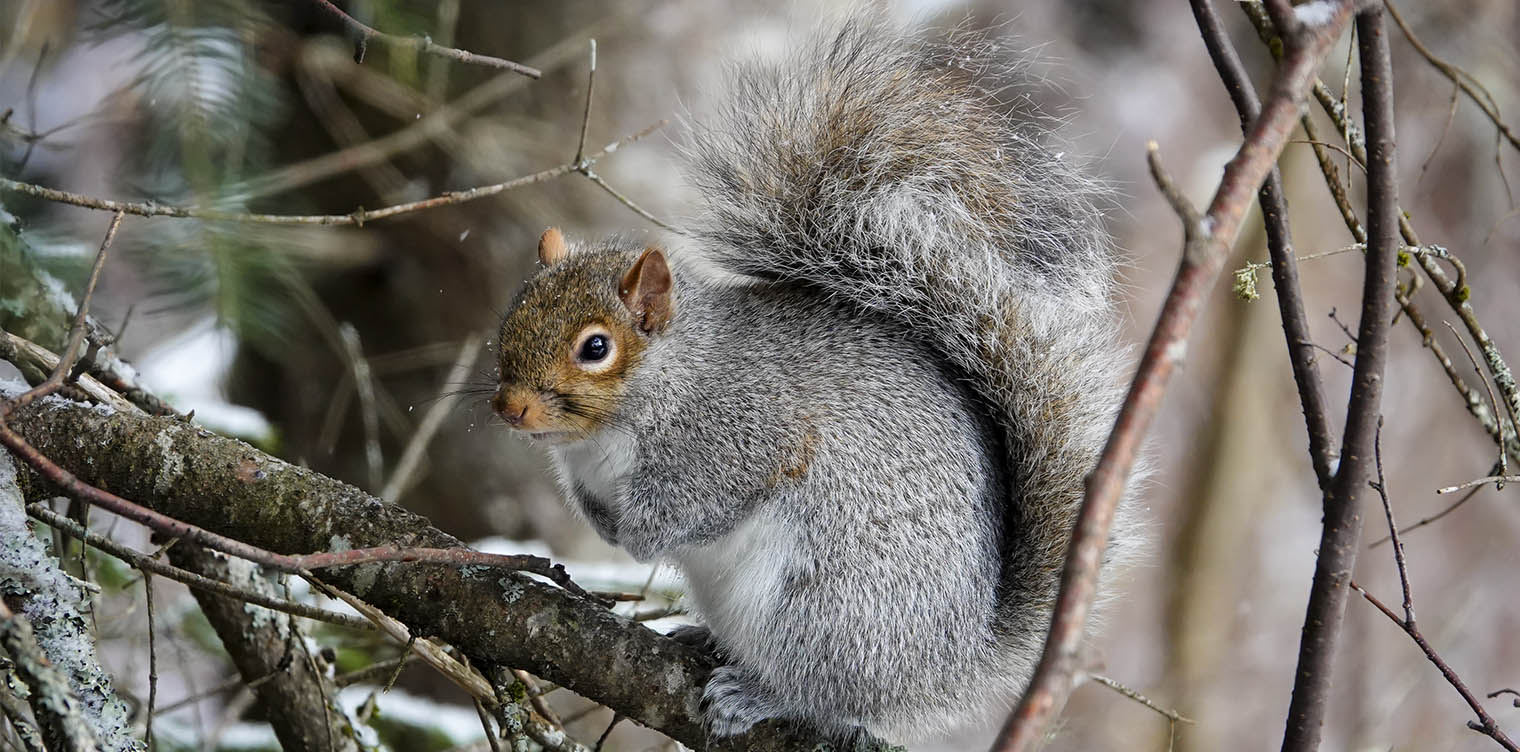
The Gray Squirrel (Sciurus carolinensis) is a medium-sized tree squirrel found in the eastern and southern margins of the Adirondack Park and around bird feeding stations in other parts of the Adirondacks. Gray Squirrels (like American Beaver and North American Porcupine) are assigned to the rodent (Rodentia) order, the single largest group of mammals.
The Gray Squirrel is one of six members of the squirrel family (Sciuridae) who make their home in the Adirondacks. The other members are:
The genus name (Sciurus) is derived from a combination of two Greek words: skia (shadow) and oura (tail) – a reference to the fact that this mammal is sometimes seen using its own tail as a source of shade.
- The species name (carolinensis) refers to the Carolinas, where the species was first recorded.
- There are 5 recognized subspecies. Ours is Sciurus carolinensis pennsylvanicus.
Other nonscientific names include Eastern Gray Squirrel, Cat Squirrel, and Black Squirrel. The latter name refers to the melanistic form of the Gray Squirrel, which is common in some areas.
Gray Squirrel: Description
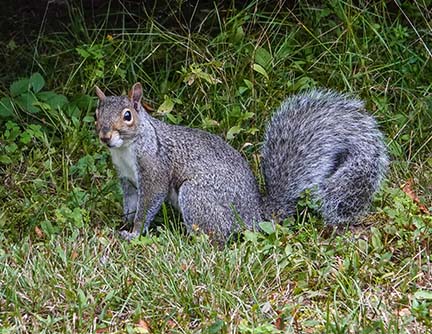
Gray Squirrels are medium-sized rodents, larger than both the Eastern Chipmunk and the Red Squirrel. The head and body measure nine to 12 inches in length, with an additional eight to ten inches of tail, for a total length of around 18 to 20 inches. Gray Squirrels weigh between 1 and 1½ pounds. Gray Squirrels in northern regions tend to be somewhat larger than those in the South. There is no sexual dimorphism in size.
Gray Squirrels have grizzled dark to pale gray coloring and a large bushy tail, which curves over the back and serves as a blanket in cold weather and as a balance for climbing and maneuvering in the trees. The hair on the tail is long and wavy, banded with brown and black at the base and tipped with white.
The Gray Squirrel's head, hips, and feet may be washed with cinnamon. The short, rounded ears are buff, gray, or white, with no tuft. The eyes appear prominent, thanks to buffy brown or white eyerings. The underparts are usually white, gray, or buffy cinnamon.
Like Red Squirrels, Gray Squirrels undergo two molts per year, resulting in seasonal differences in appearance. The spring molt, which begins on the head and progresses toward the hindquarters, produces a more yellowish summer coat by late spring. The fall molt begins in September on the flanks and progresses toward the head, producing a denser and more silvery winter coat. In northern regions, the ears become heavily furred and the foot soles densely haired in the winter.
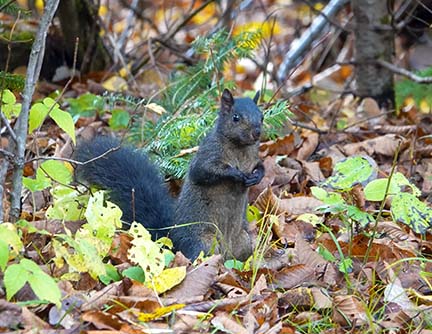
The melanistic form of the Gray Squirrel, sometimes known as the Black Squirrel, has black upper parts and brown or pale brown underparts. Melanism is seen in several species of squirrels and is most common in Gray Squirrels and Fox Squirrels. Researchers have found that the black coloration in both species is the result of an abnormal pigment gene.
For Gray Squirrels, the black morph is quite common in some areas, particularly urban areas and the northern and northeastern parts of the Gray Squirrel's range. In Michigan and Ontario, black morphs are said to form the majority of the species' population. Black morphs of the Gray Squirrel have reportedly become more common in some areas of the Adirondacks.
There are several theories explaining the frequencies of black morphs in northern regions.
- One theory is that squirrels with darker fur may be better able to keep warm in our cold winters. For instance, a 1989 study of Gray and Black Squirrels in the suburbs of Quebec found that black individuals have a lesser rate of estimated heat loss in the cold than gray ones. These results are consistent with the reported predominance of melanistic morphs in the northern part of the species' distribution. A 2019 study of the prevalence of black morphs based on citizen science reporting found that black morphs were more common in areas with cool annual temperature.
- Another theory is that the darker fur may provide more camouflage in dark forests. However, a 1990 study of gray and black squirrel behaviors in Syracuse, New York, found no differences between the color morphs in wariness, suggesting that differential predation is not a significant factor.
The main clues to identifying the Gray Squirrel and distinguishing it from other rodents found in the Adirondacks are size, color, markings, and activity pattern.
- Gray Squirrels are much larger than both Eastern Chipmunks (which average 9.6 inches in length and weigh about three ounces) and Red Squirrels (which are about 11-13 inches long and weigh five to eight ounces).
- Gray Squirrels have gray (or in some cases, black) coats, contrasting with both the Red Squirrel's chestnut-red upper parts and the Eastern Chipmunk's prominent longitudinal body stripes
- Northern Flying Squirrels and Southern Flying Squirrels have large black eyes (lacking the eye ring of Gray Squirrels) and brownish coats with a furry membrane between the front and rear legs used to glide through the air. Unlike Gray Squirrels, flying squirrels are nocturnal.
Gray Squirrels are smaller than the similar Fox Squirrel (Sciurus niger). Moreover, Gray Squirrels lack the Fox Squirrel's tufted ears and (although the ranges overlap in other parts of North America), the Fox Squirrel is not found in the Adirondack Park.
Gray Squirrel: Diet
The Gray Squirrel is an omnivore Omnivore: Animals that eats both plant- and animal-derived food. Carnivores (meaning "meat-eaters" in Latin) are animals that feed on other animals; obligate carnivores (such as members of the cat family) rely entirely on animal flesh, while facultative carnivores supplement their diets with non-animal foods. Herbivores feed exclusively on plants, although some may supplement their diets with small amounts of insects or other animals. , meaning that it consumes both plant and nonplant material. Plant material is the squirrel's mainstay, and a large variety of plant food is consumed, depending on the season and local availability.
- In the Adirondacks, the main items on the Gray Squirrel's menu are seeds and nuts, particularly beech nuts. Acorns, which play a major role in the Gray Squirrel's diet in many parts of their range, are of lesser importance here, because of the relative scarcity of oak trees. In late winter and spring, Gray Squirrels consume buds, flowers, and the inner bark of trees, while fungi, berries, and fruits make up a large part of the Grey Squirrel menu in summer.
- Although Gray Squirrels are primarily herbivorous, they also prey on insects, such as beetles and caterpillars, particularly in spring and summer when their preferred foods are less plentiful. They are also reported to consume frogs, smaller rodents, and the eggs and young of birds. Gray Squirrels are considered to be less carnivorous than other tree squirrels, including the Red Squirrel, which is a probable or confirmed nest predator of a long list of bird species.
Like the Red Squirrels and other members of the Sciuridae family, Gray Squirrels are scatter-hoarders. They bury nuts in the fall for consumption during the winter and spring, digging shallow holes and depositing the nuts an inch or so in the ground. They apparently rely on a combination of spatial memory and their keen sense of smell to retrieve their stored nuts.
Gray Squirrel: Reproduction and Family Life
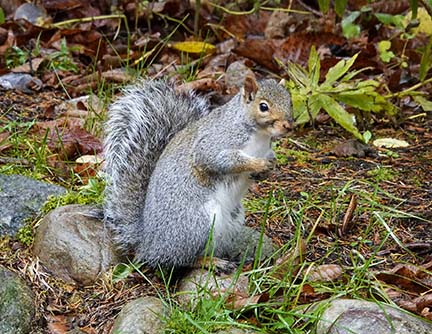
Gray Squirrels have two breeding periods: one in late winter and the second in mid-summer. Female Gray Squirrels generally become fertile when they are about one year old, while male Grey Squirrels become sexually mature between one and two years of age.
The courtship cycle begins with one or more males engaging in mating chases with a female in estrous. The female usually mates with the dominant male.
After becoming pregnant, females construct a nest in which to bear and raise their young. Throughout the Gray Squirrel's range, most winter to spring litters are born in tree cavities, while most spring to summer litters are born in leaf nests. Some observers have speculated that reliance on tree cavities is higher in colder climates like the Adirondacks.
The gestation period for Gray Squirrels is about 44-45 days, with young born in late spring from the first breeding cycle and then again in mid-summer from the second. Typical litter size is two to three young. The young are born blind and essentially hairless. They are weaned at eight to ten weeks, but the young may not switch to a complete diet of solid food until they are 10 or 12 weeks old. Young squirrels usually leave the nest and begin foraging after 12 weeks. Young from late summer litters may remain with their mother over the winter. Males are not involved in care of the young; females provide the only care.
Gray Squirrel: Behavior
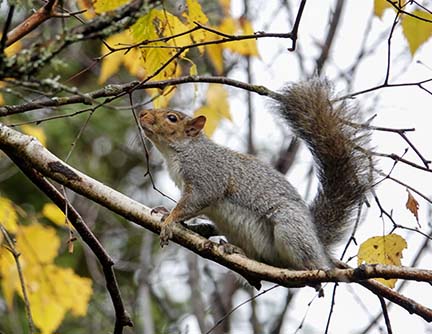
Activity Patterns:
Like other pine squirrels, Gray Squirrels are active during daylight hours. From spring through fall, they are most active in the two to three hours following sunrise and the two to three hours preceding dusk. During winter, their activity level peaks two to four hours before sunset.Like Red Squirrels, Gray Squirrels are active throughout the year. They do not hibernate in winter (like Woodchucks) or spend winter in their dens in a state of intermittent torpor (like Eastern Chipmunks). However, the Gray Squirrel's activity level is lower in winter. During periods of severe winter weather, they may stay in their nests for several days, coming out briefly at midday to forage for the nuts buried in the fall.
Gray Squirrels use both leaf nests and cavity nests for shelter, nesting, and escape.
- Leaf nests are constructed of leaves and twigs and are usually about a foot in diameter. The interior is lined with shredded leaves and strips of bark woven together to make the nest virtually waterproof. Leaf nests are generally placed about 25-35 feet from the ground in a crotch or fork of a limb.
- Tree cavities used as dens are found in a variety of tree species, usually situated in the trunk or in a large limb. Cavity nests may be preferred in regions with cold winters, such as the Adirondacks. Leaf nests are generally used in warmer months, while den cavities are preferred in winter.
Gray Squirrels are arboreal acrobats, using their long tails for balance and leaping with agility from branch to branch. They can descend a tree head-first, pointing the claws of their hind paws backward to grip the tree bark. Gray Squirrels are also agile on the ground and spend a fair amount of time there, especially in the fall when they are busy collecting and burying nuts. They reportedly can run at speeds of up to 14 miles per hour.
Social System:
Gray Squirrels are not social, but they are not as territorial as Red Squirrels, who will fiercely defend their territory against other squirrels. The home ranges of Grey Squirrels vary from one to 25 acres, depending on food availability. Home range size generally increases with age. Home ranges are often overlapping. Female Gray Squirrels are normally subordinate to males, except when they have litters and are defending small territories around their dens.Communication:
Gray Squirrels communicate through visual, tactile, auditory and olfactory interactions. They have a varied repertoire of vocalizations. When disturbed, they use "kuks," barks, chucks, squalls, or moans. These vocalizations may be accompanied by foot-stamping and tail-waving. Gray Squirrels tend to be less vocal and much less noisy than the smaller, but much more pugnacious, Red Squirrel.Gray Squirrel: Mortality and Predators
Gray Squirrels face a variety of predators. Mammalian predators include Raccoons (reported to play a major role in predation on nestlings), Bobcats, Eastern Coyotes, Gray Foxes, Red Foxes, Minks, Long-tailed Weasels, Fishers, domestic dogs, and domestic and feral cats. Red-tailed Hawks, Red-shouldered Hawks, Cooper's Hawks, Bald Eagles, and Barred Owls also reportedly prey on Gray Squirrels.
Human sources of mortality for Gray Squirrels include hunting and motor vehicles. In our part of New York State, hunting season for Gray Squirrels is from 1 September through 28 February, sunrise to sunset. There is a bag limit of six squirrels. While data for Gray Squirrels killed by hunters in New York State are not available, according to DEC estimates, squirrels (both Gray Squirrels and Fox Squirrels) are popular targets for New York hunters. Statewide, an estimated 30,000 hunters participate in the sport, with an estimated number of animals killed at 142,194.
Despite being a food item for many predators, predation does not appear to pose a major limit on Gray Squirrel populations. Survival, particularly of juvenile Gray Squirrels, appears to be more related to variation in food availability. Mortality during the first year of life in an unhunted population is about 75%. Potential longevity, based on captive Gray Squirrels, is at least twenty years. In nature, however, Gray Squirrels rarely live more than six years.
Gray Squirrel: Distribution
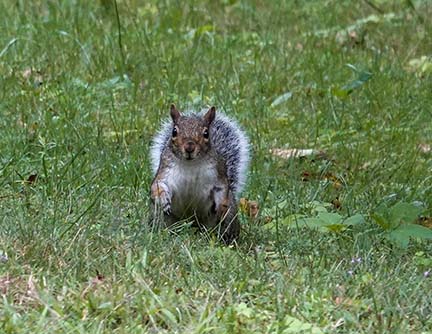
Gray Squirrels are found in the eastern half of North America. Their range extends from the Atlantic Coast to the eastern border of the Great Plains and from the Gulf Coast to slightly north of the US border with Canada. This species has been introduced on the west coast in the US, including California, Montana, and Oregon. The range has also been extended in Canada through introductions into Quebec, New Brunswick, and British Columbia.
Gray Squirrels have also been introduced to some regions in Europe (including Italy, England, and Scotland). Their populations have expanded rapidly due to scarcity of natural predators and their ability to compete successfully for food. Gray Squirrels are considered an invasive species that threatens both the local ecosytem and native squirrel species. In Ireland, for instance, Gray Squirrels have displaced the Eurasian Red Squirrel.
Gray Squirrels are found throughout New York State and are common in many parts of the state. However, within the Adirondack Blue Line, they are less common than our other native rodents. The pattern of iNaturalist observations for late 2020 shows 37 research-grade observations for Gray Squirrels, compared to 152 for Red Squirrels and 147 for Eastern Chipmunks.
This pattern reflects the Gray Squirrel's habitat and food preferences. Gray Squirrels are most abundant in deciduous forests, especially areas with oak trees. They are more likely to be seen in the deciduous forests along the eastern and southern margins of the Park, including the Champlain Valley. In other parts of the Adirondacks, they appear to be limited to villages and other populated areas where they can get access to residential bird feeding stations.
Gray Squirrel Habitat
Like Red Squirrels, Gray Squirrels are found in both hardwood and mixed wood forests. In contrast to Red Squirrels (which have a strong affinity for conifer forests), Gray Squirrels are most abundant in mature hardwood stands dominated by mast producing trees. They prefer sites with canopies dense enough to permit continuous travel through the tree crowns and tall trees for cavity dens or leaf nests.
In the Adirondack Mountains, Gray Squirrels are also found in populated areas. They are more commonly seen in village parks than along most of the trails covered here. They are frequent visitors to winter bird feeders and make use of their acrobatic skills and agility to gain access to squirrel-proof feeders.
Adirondack Mammal List
References
New York State Department of Environmental Conservation. Small Game Hunting. Retrieved 15 November 2020.
New York State Department of Environmental Conservation. Squirrel Hunting Seasons. Retrieved 15 November 2020.
David Figura. DEC survey: What animals are most popular among New York's small game hunters? Retrieved 28 January 2019.
State University of New York. College of Environmental Science and Forestry. Gray Squirrel. Sciurus carolinensis Ord. Retrieved 15 November 2020.
John L. Koprowski, “Sciurus carolinensis,” Mammalian Species, Number 480, (2 December 1994), pp. 1-9. Retrieved 15 November 2020.
Integrated Taxonomic Information System On-line Database. Sciurus carolinensis. Retrieved 15 November 2020.
James W. Teaford. Eastern gray squirrel (Sciurus carolinensis). US Army Corps of Engineers Wildlife Resources Management Manual. Section 4.7.1. (July 1986). Retrieved 15 November 2020.
F. Cassola. Eastern Gray Squirrel. Sciurus carolinensis. The IUCN Red List of Threatened Species 2016. Retrieved 15 November 2020.
D. Andrew Saunders. Adirondack Mammals (Adirondack Wildlife Program. State University of New York. College of Environmental Science and Forestry, 1988 ), pp. 85-89.
William K. Chapman. Mammals of the Adirondacks. A Field Guide (North Country Books, 1991), p. 56, Plate 12.
John O. Whitaker, Jr. and William J. Hamilton, Jr. Mammals of the Eastern United States. Third Edition (Cornell University Press, 1998), pp. 223-229 . Retrieved 14 November 2020.
New York State. Department of Environmental Conservation. New York Natural Heritage Program. Ecological Communities of New York State. Second Edition (March 2014), p. 83. Retrieved 17 October 2015.
iNaturalist. Eastern Gray Squirrel. Sciurus carolinensis. Retrieved 15 November 2020.
iNaturalist. Adirondack Park Sightings. Eastern Gray Squirrel. Sciurus carolinensis. Retrieved 15 November 2020.
Alexander C. Martin, Herbert S. Zim, and Arnold L. Nelson. American Wildlife & Plants. A Guide to Wildlife Food Habits (Dover Publications, 1951), p. 232. Retrieved 14 November 2020.
James M. Ryan. Adirondack Wildlife. A Field Guide (University of New Hampshire Press, 2008), pp. 194.
Donald W. Stokes and Lillian Q. Stokes. A Guide to Animal Tracking and Behavior (Little, Brown and Company, 1986), pp. 30-31, 76-79, 102-103, 118-119, 198-207.
James C. Halfpenny and Jim Bruchac. Scats and Tracks of the Northeast: A Field Guide to the Signs of Seventy Wildlife Species (Falcon, 2001), pp. 116-117
William Henry Burt. A Field Guide to the Mammals of North America North of Mexico. Third Edition (Houghton Mifflin Company, 1980), pp. 117-119. Retrieved 14 November 2020.
Luigi Boitani and Stefania Bartoli. Simon & Schuster's Guide to Mammals (Simon & Schuster, 1982), 140-141. Retrieved 14 November 2020.
National Geographic Society. Wild Animals of North America (National Geographic Society, 1995), p. 126. Retrieved 14 November 2020.
Adrian Forsyth. Mammals of North America. Temperate and Arctic Regions. (Firefly Books, 2006), pp. 109-110. Retrieved 17 November 2020.
Richard M. DeGraaf and Mariko Yamasaki. New England Wildlife: Habitat, Natural History, and Distribution (University Press of New England, 2001), pp. 124-125. Retrieved 14 November 2020.
Richard M. DeGraaf, Gretchin M. Witman, and Deborah D. Rudis. Forest habitat for Mammals of the Northeast (US Department of Agriculture. Forest Service, 1981), pp. 80-81. Retrieved 7 March 2020.
John Edwards, Mark Ford, and David Guynn, "Fox and Gray Squirrels," in George A. Feldhamer, Bruce C. Thompson, and Joseph A. Chapman (Eds). Wild Mammals of North America: Biology, Management, and Conservation. Second Edition (The Johns Hopkins University Press, 2003) pp. 248-267 .
Frederick Schenck Barkalow and Monica Shorten. The World of the Gray Squirrel (Lippincott, 1973).
Allen Kurta. Mammals of the Great Lakes Region. Revised Edition. (University of Michigan, 1995), pp. 123-126. Retrieved 16 November 2020.
Clinton Hart Merriam. The Vertebrates of the Adirondack Region, Northeastern New York (Press of L.S. Poster, 1882), pp. 28. Retrieved 2 March 2017.
Clinton Hart Merriam. The Mammals of the Adirondack Region, Northeastern New York (Self-published, 1884), pp. 219-232. Retrieved 2 March 2017.
Gerrit S. Miller, “Preliminary List of New York Mammals,” Bulletin of the New York State Museum, Volume 6, Number 29 (October 1899), pp. 273-390. Retrieved 15 November 2020.
Cornell Lab of Ornithology, Ithaca, New York. Birds of North America. Subscription Web Site. Northern Goshawk (Accipiter gentilis). Retrieved 15 November 2020.
Helen R. McRobie, Nancy D. Moncrief and Nicholas I. Mundy, “Multiple Origins of Melanism in Two Species of North American Tree Squirrel (Sciurus),” BMC Evolutionary Biology, Volume 19, Article 140 (2019). Retrieved 15 November 2020.
Michel B. Ducharme, Jacques Larochelle and Denis Richard, “Thermogenic Capacity in Gray and Black Morphs of the Gray Squirrel, Sciurus carolinensis,” Physiological Zoology, Volume 62, Number 6 (November - December, 1989), pp. 1273-1292. Retrieved 15 November 2020.
Eric J. Gustafson and Larry W. VanDruff, “Behavior of Black and Gray Morphs of Sciurus carolinensis in an Urban Environment,” The American Midland Naturalist, Volume 123, Number 1 (January 1990), pp. 186-192. Retrieved 15 November 2020.
Richard M. Lehtinen, Brian M. Carlson, Alyssa R. Hamm, Alexis G. Riley, Maria M. Mullin, and Weston J. Gray, “Dispatches From the Neighborhood Watch: Using Citizen Science and Field Survey Data to Document Color Morph Frequency in Space and Time,” Ecology and Evolution, Volume 10, Issue 3 (February 2020), pp. 1526-1538. Retrieved 19 November 2020.
James P. Gibbs, Matthew F. Buff and Bradley J. Alligator , “The Biological System – Urban Wildlife, Adaptation, and Evolution: Urbanization as a Driver of Contemporary Evolution in Gray Squirrels (Sciurus carolinensis), in Myrna H. P. Hall and Stephen B. Balogh (eds.). Understanding Urban Ecology: An Interdisciplinary Systems Approach (Springer International Publishing, 2019), pp. 269-286.
F. S. Barkalow, Jr. and R. F. Soots, Jr.,”Life Span and Reproductive Longevity of the Gray Squirrel, Sciurus c. carolinensis Gmelin,” Journal of Mammalogy, Volume 56, Number 2 (May 1975), pp. 522-524. Retrieved 23 November 2020.
Mark K. Brown and Gary Will, "Food Habits of the Fisher in Northern New York," New York Fish and Game Journal, Volume 26, Number 1 (January 1979), pp. 87- 92. Retrieved 2 April 2019.
W.J. Hamilton, "The Squirrels of New York," New York State Conservationist, Volume 11, Number 4 (February-March 1957), pp. 23-27. Retrieved 2 April 2019.
Dennis A. Riege, "Habitat Specialization and Social Factors in Distribution of Red and Gray Squirrels," Journal of Mammalogy, Volume 72, Number 1 (February 1991), pp. 152-162. Retrieved 15 February 2019.
